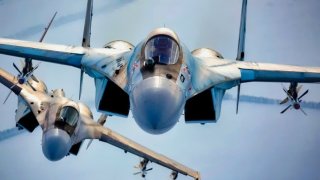Russia's Su-35 Flanker Fighter Nightmare Keep Getting Worse
The Russian Air Force is facing significant setbacks in its ongoing conflict in Ukraine, with substantial losses including several Su-35 fighter jets
Summary: The Russian Air Force is facing significant setbacks in its ongoing conflict in Ukraine, with substantial losses including several Su-35 fighter jets. As Moscow intensifies its aerial assaults, the strain on its military arsenal grows, with more than 150 sorties involving Su-34 and Su-35 airframes reported over just 13 days earlier this year.
-The Su-35, developed from the Su-27 Flanker, was designed to be highly maneuverable and compete with U.S. fourth-generation fighters. However, despite its advanced capabilities and armament, the Su-35 has struggled against Ukraine's sophisticated air-defense systems, including the American-made Patriot missile system.
-With ongoing heavy losses and the continuous inflow of Western military aid to Ukraine, Russia's aerial operations are under severe pressure, questioning the sustainability of its air superiority strategy.
Su-35 Losses Mount as Russia Faces Uphill Battle in Ukraine’s Skies
Russian forces are struggling to contend with a greatly reduced military arsenal amidst its ongoing Ukraine invasion. Over the last two-plus years, Moscow has lost a great deal of main battle tanks, airframes, infantry fighting vehicles and other weaponry it is depending on to continue its offensive efforts.
Last month, another Soviet-era Su-35 fighter jet was destroyed when it crashed near occupied Sevastopol. In February, the Air Force Command of Ukraine’s Armed Forces claimed that it had taken out another Su-35, in addition to a pair of Su-35 fighter bombers.
The current trajectory of these losses does not bode well for Russia’s aerial capabilities. Moscow is carrying out greater aerial bombardments over Ukraine, contributing to the increased loss of its aircraft. According to reports, the Russian air force has launched more than 150 sorties involving the Su-34 and Su-35 airframes over a span of 13 days earlier this year, a huge uptick when compared to previous surges.
Each of these fighters can pack an assortment of bombs or rockets, which pose a massive threat to Ukrainian troops on the ground. For this reason, destroying as many S-34s and Su-35s as possible remains a top priority for Kyiv.
Introducing the Su-35
The Su-35 was conceptualized during the Cold War, as Soviet officials desired a new supermaneuverable airframe that could go head-to-head against America’s own fleet of fourth-generation fighters.
The McDonnell Douglas F-15 Eagle and the Northrop Grumman F-14 Tomcat were particularly threatening to the USSR’s rapidly aging arsenal of jets at the time. Based heavily on the Su-27 “Flanker” fighter, the Su-35 was designed to sport a range of cutting-edge advancements.
The Su-35 became the designation for two improved variants of the Flanker and took its first maiden flight in the late 1980s. Since the platform’s introduction to service with the Russian Air Force in 2014, the fighter has remained a critical component of the country’s aerial strategy.
Following the dissolution of the Soviet Union, production of the Su-35 ceased in the mid-1990s. Only a dozen of these airframes were constructed at this point. When it resumed, a slightly modified variant emerged- the Su-35S. The platform shares the blended wing-body design of the Flanker but can be visually distinguished from the basic version by the incorporation of canards ahead of the wings.
The Su-35, designated by the North Atlantic Treaty Organization (NATO) as the ”Flanker-E,” has a maximum take-off weight of 34.5 tons, an operational range of up to 4,500 km and a service ceiling of 20,000 meters.
In terms of ordnance, the Flanker-E is well-armed. The fighter can be equipped with an array of guided bombs, including the KAB-500Kr TV-guided bomb, KAB-500S-E satellite-guided bomb, LGB-250 laser-guided bomb, Kab-1500Kr TV-guided bomb and KAB-1500LG laser-guided bomb.

According to Airforce Technology, the Su-35 also features countermeasures and guns like a radar warning system, jammer and the Gryazev-Shipunov 30mm GSh-30-1 gun.
How has the Su-35 Flanker-E fared in Ukraine?
While the Kremlin often touts that its fleet of Flanker E fighters is top-notch, this platform has not performed well in the Ukraine war. Kyiv has deployed its most advanced missile systems, including the American-made Patriot, to thwart Moscow’s aerial capabilities.
The Flanker Es are air superiority fighters. However, they have not been able to evade more sophisticated air-defense missiles that are being provided to Ukraine from Western countries. As of February, Moscow has lost at least two dozen of their 150 Su-34s and half a dozen of their 120 Su-35s. This number has likely increased since then, but it is impossible to verify the exact amount.
As the war drags on and Ukraine receives additional weapons shipments from the U.S. and other NATO allies, the rate at which Moscow is losing its top fighter platform will no longer be sustainable.
About the Author: Maya Carlin
Maya Carlin, National Security Writer with The National Interest, is an analyst with the Center for Security Policy and a former Anna Sobol Levy Fellow at IDC Herzliya in Israel. She has by-lines in many publications, including The National Interest, Jerusalem Post, and Times of Israel. You can follow her on Twitter: @MayaCarlin.
All images are Creative Commons.


